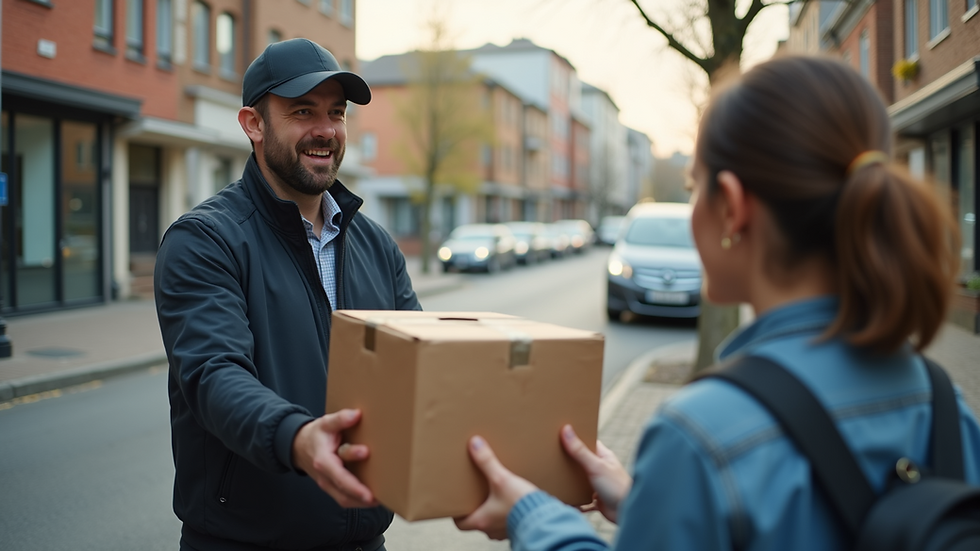Trusted Last-Mile Delivery Network in the United States
- 8月6日
- 讀畢需時 4 分鐘
In today's fast-paced world, the demand for quick and reliable delivery services has never been higher. With the rise of e-commerce, consumers expect their packages to arrive at their doorsteps faster than ever. This is where last-mile delivery comes into play. It is the final step in the delivery process, where goods are transported from a distribution center to the final destination. In the United States, a trusted last-mile delivery network is essential for businesses and consumers alike.
This blog post will explore the importance of last-mile delivery, the challenges it faces, and how companies are innovating to create a more efficient and reliable network.
Understanding Last-Mile Delivery
Last-mile delivery refers to the last leg of the shipping process. It is the journey that a package takes from a local distribution center to the customer's doorstep. This stage is crucial because it directly impacts customer satisfaction.
Here are some key points to understand about last-mile delivery:
Speed: Customers want their packages quickly. The faster the delivery, the happier the customer.
Cost: Last-mile delivery can be expensive. Companies must balance speed with cost-effectiveness.
Technology: Many companies are using technology to improve last-mile delivery. This includes route optimization software and real-time tracking.
Customer Experience: A smooth last-mile delivery process enhances the overall customer experience.
The Importance of a Trusted Network
A reliable last-mile delivery network is vital for several reasons:
Customer Satisfaction: When customers receive their packages on time, they are more likely to be satisfied with their purchase. This leads to repeat business and positive reviews.
Competitive Advantage: Companies that can offer faster and more reliable delivery options stand out in a crowded market.
Operational Efficiency: A well-organized last-mile delivery network can reduce costs and improve efficiency.
Brand Loyalty: Consistent and reliable delivery builds trust with customers, leading to brand loyalty.
Challenges in Last-Mile Delivery
Despite its importance, last-mile delivery faces several challenges:
Traffic Congestion: Urban areas often experience heavy traffic, which can delay deliveries.
Rising Costs: Fuel prices and labor costs are continually increasing, making last-mile delivery more expensive.
Customer Expectations: As e-commerce grows, so do customer expectations. They want faster delivery times and more flexibility in delivery options.
Returns Management: Handling returns efficiently is a significant challenge for last-mile delivery networks.
Innovations in Last-Mile Delivery
To address these challenges, companies are adopting innovative solutions. Here are some examples:
1. Drones and Autonomous Vehicles
Drones and autonomous vehicles are becoming more common in last-mile delivery. They can navigate traffic and deliver packages quickly. Companies like Amazon are testing drone delivery systems to speed up the process.
2. Smart Lockers
Smart lockers provide a secure location for customers to pick up their packages. This reduces the need for home delivery and can save time. Companies like UPS and Amazon have implemented smart locker systems in various locations.
3. Route Optimization Software
Using advanced algorithms, route optimization software helps delivery drivers find the most efficient routes. This reduces delivery times and fuel costs. Companies like FedEx and DHL are investing in this technology.
4. Crowdsourced Delivery
Crowdsourced delivery involves using local individuals to deliver packages. This can be a cost-effective solution for last-mile delivery. Companies like Postmates and DoorDash have successfully implemented this model.
The Role of Technology in Last-Mile Delivery
Technology plays a crucial role in enhancing last-mile delivery. Here are some ways it is being utilized:
Real-Time Tracking: Customers can track their packages in real-time, providing transparency and peace of mind.
Mobile Apps: Many companies have developed mobile apps that allow customers to manage their deliveries easily.
Data Analytics: Companies are using data analytics to understand customer behavior and improve delivery processes.
Case Studies of Successful Last-Mile Delivery Networks
Amazon
Amazon has revolutionized last-mile delivery with its Prime service. By offering same-day and next-day delivery, Amazon has set a high standard for the industry. Their use of technology, such as drones and advanced logistics, has made them a leader in last-mile delivery.
UPS
UPS has invested heavily in technology to improve its last-mile delivery network. Their ORION software optimizes delivery routes, saving time and fuel. UPS also offers a range of delivery options, including same-day delivery and access points for package pickup.
FedEx
FedEx has embraced innovation in last-mile delivery by using smart lockers and crowdsourced delivery. Their Flex service allows customers to choose delivery times and locations, enhancing the customer experience.
The Future of Last-Mile Delivery
The future of last-mile delivery looks promising. As technology continues to evolve, we can expect to see even more innovations. Here are some trends to watch:
Sustainability: Companies are focusing on eco-friendly delivery options, such as electric vehicles and bike couriers.
Personalization: Customers will have more control over their delivery preferences, including time and location.
Increased Automation: Automation will play a larger role in last-mile delivery, from sorting packages to delivering them.
Building a Trusted Last-Mile Delivery Network
To build a trusted last-mile delivery network, companies should focus on the following:
Invest in Technology: Embrace new technologies that enhance efficiency and customer experience.
Understand Customer Needs: Listen to customer feedback and adapt delivery options accordingly.
Optimize Operations: Continuously evaluate and improve delivery processes to reduce costs and improve speed.
Foster Partnerships: Collaborate with local businesses and delivery services to expand reach and improve service.
Final Thoughts
The last-mile delivery network is a critical component of the supply chain. As consumer expectations continue to rise, companies must adapt and innovate to meet these demands. By investing in technology, understanding customer needs, and optimizing operations, businesses can build a trusted last-mile delivery network that enhances customer satisfaction and drives growth.

In a world where convenience is king, a reliable last-mile delivery network is not just an option, it is a necessity. The companies that succeed in this space will be those that prioritize efficiency, customer experience, and innovation. As we look to the future, the evolution of last-mile delivery will undoubtedly shape the way we shop and receive goods.


留言